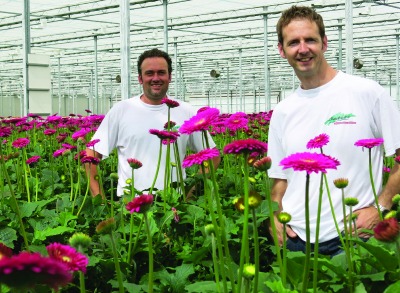
Aug. 7, 2014 — Biobest has invested substantially in research programs aimed at making more efficient use of natural enemies.
Aug. 7, 2014 — Biobest has invested substantially in research programs aimed at making more efficient use of natural enemies.
Integrated Pest Management in ornamentals is rapidly gaining ground, including with gerbera crops. Growers use a variety of biological control agents. The predatory mite A. swirskii is often one of the pillars of the biological strategy for whitefly control. It also helps to control thrips and broad mites, two pests that have become increasingly difficult to control in recent years.
With the introduction of Nutrimite™, the food supplement that boosts the development of predatory mites in the crop, Biobest offers gerbera growers a simple path to achieve optimal reliability of their biocontrol program.
By applying Nutrimite on the crop, the predatory mite population develops much faster and better, even in the absence of pests.
CASE STUDY
Westmade CV, a gerbera grower in the Dutch province of North-Brabant, started working with Nutrimite this year.

|
| Gerbera grower Westmade C.V. is based in Made, the Netherlands. |
Grower Kevin Batist explains why. “Last year we were still in doubt as to whether we would really opt for integrated pest management. The thrips pressure was very high, and we decided to place our bets on chemical control. The results were not satisfactory. With chemical control, it's just no longer possible to guarantee a clean crop."
This year they decided, in consultation with Biobest, to go for a fully integrated approach.
“Biobest advisor Wesley Akkermans offered us a tailor-made and innovative program,” explains manager Jürgen Hochstenbach. “By experience we knew that the predatory mite Amblyseius cucumeris, even when released in high numbers, would not always provide sufficient control of thrips and broad mites.
ALSO BETTER CONTROL OF BROAD MITES AND THRIPS
“This year, the predatory mite army in our crop is stronger than we've ever seen before. This was achieved with release of a Swirskii-system in combination with Nutrimite, as advised by Wesley. It is already obvious that we have achieved much better control of broad mites.
“Thrips pressure is also much lower than usual,” he adds.
"In gerbera we've already had good experience working with A. Swirskii,” says Akkermans. “In view of the excellent results with Nutrimite in cucumber, I was really convinced that the combination Swirskii system with Nutrimite would work well in gerbera.
"We know that A. swirskii can establish in gerbera and that it feeds on larvae of thrips, eggs of whitefly and broad mites. By applying Nutrimite on the crop, the predatory mite population develops much faster and better, even in the absence of pest.
“There are several Gerbera varieties in this greenhouse. Everywhere we observe much higher predatory mite densities than ever before. Also, later in the season, when there is a natural decline of predatory mite populations, we expect that this strategy will allow us to keep the upper hand over broad mites and thrips.”
Print this page